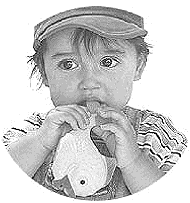 PVC (polyvinyl chloride) is a versitile polymer often used in children's toys to make soft plastics such as rubber ducks and freezable teething rings. PVC itself is brittle and degrades easily, and so is mixed with plasticizers. The plasticizers have a high potential for leaching, as they are not actually bonded to the PVC, but rather float around it. Chewing on the polymer dramatically increases leaching, and provides an excellent avenue for the plasticizer to enter the body. The most common plasticizers for soft toys are phthalate esters. Laboratory tests have identified a range of effects of the exposure to phthalates, including liver and kidney lesions, reproductive abnormalities (testicular atrophy, altered reproducitve tissue development, and subtle changes in sperm production), cell line transformations, and cancer of the liver, kidney, and mononuclear cell leukemia. Alternatives for PVC in children's toys include thermoplastics, such as polypropylene, and thermoplastic elastomers. More information on PVC toys may be found on the Greenpeace web page at www.greenpeace.org. Thanks also to Greenpeace for the graphics on this page. |
Main Menu - List of Homewreckers